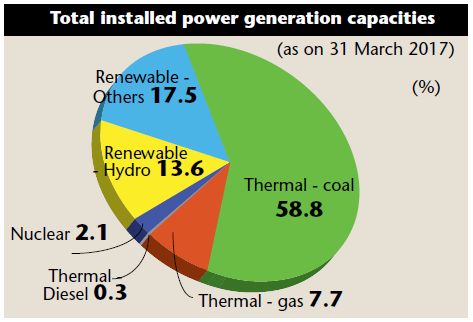
Government has a clear focus on promoting clean energy
India’s energy sector is dominated by traditional energy sources, comprising primarily of oil, gas and coal. These constitute about 85 per cent of India’s total energy consumption, followed by renewable energy, which takes care of about 13 per cent of the pie. This trend is fast changing, as government is shifting its focus from traditional sources to cleaner and renewable sources of energy.
In a bid to reduce emissions, the Supreme Court had banned the sale and registration of non-BS IV compliant vehicles with effect from 1 April 2017. The government has been encouraging development of electric vehicles (EVs) for the Indian market. This paradigm shift towards electric vehicles is going to be a game-changer for the Indian economy in general and our energy sector in particular, as it will curtail demand for oil and gas in the long run. India, being a net importer of crude oil at present, is expected to benefit immensely from the ongoing shift towards electric vehicles. Also, this shift is expected to strengthen India’s fiscal position in the years to come.
While companies are waiting for more clarity on the policy front, many corporates have already started investing in the development of technologies and infrastructure for electric vehicles. Several auto companies have aggressively scheduled product launches of electric vehicles over the next five years. The government has plans to make India a 100 per cent electric vehicle nation by 2030. Transport authorities across states have shown their keen interest in rolling out electric bus services.
India is the world’s third largest producer of electricity, with a total installed capacity of 329 GW as of 31 August 2017. Thermal energy, comprising coal, gas and diesel power, constitutes about two-thirds of the total installed capacity, followed by renewable energy and nuclear power, comprising about a 31 per cent and 2 per cent share in the pie respectively.
During the last few years, the power sector in India has been witnessing major changes, with the government promoting cleaner energy, such as wind, solar and hydro power, among others, in a bid to provide rapid electrification to the entire country. There is a sharp increase in the capacity additions in the renewable energy space. On the other hand, the fossil energy space has been witnessing a sharp slowdown in capacity additions, as is seen in the statistics of April-August 2017. Only 3,790 MW of fresh capacity was added during the period, as against a targeted addition of 14,956 MW for 2017-18.
The outlook for new capacities in the thermal power space looks bleak, as there are no fresh long-term power purchase agreements (PPAs) signed. Additionally, there is a sharp fall in the tariffs for renewable energy, competing aggressively with thermal power tariffs. To reduce its dependence on coal mining, India’s largest coal mining company, Coal India, too has announced its intention to diversify into mining of other minerals such as
bauxite, nickel, iron ore, etc.
Tariffs for wind and solar energy, which used to be prohibitively high a few years back, are now seen competing strongly with thermal power. Solar power tariffs were Rs 2.65-3.36 per unit last month for 500 MW capacities, as compared to the all-time low tariffs of Rs 2.44 per unit in May 2017. Wind power tariffs have fallen to a record low of Rs 2.64 per unit in the auction conducted by SECI for 1 GW capacities. The government aims to bring power tariffs to Rs 3 per unit, irrespective of the source in the medium term.
The popularity of electric vehicles is all set to rise, with power tariffs becoming more affordable – driven by an increase in renewable power capacities. The development of improved technologies and supporting infrastructure facilities will further push demand for electric vehicles in the country. A clear shift from subsidized fuel towards low-priced clean energy is expected now, which ought to be beneficial for the country. The share of oil, gas and coal in India’s energy sector is expected to fall, while the share of cleaner and renewable energy is expected to rise in the years to come.
This article was originally published in Business India Magazine.
Write to us at news@valuelineadvisors.com
Disclaimer: The views expressed in this article are personal and the author is not responsible in any manner for the use which might be made of the above information. None of the contents make any recommendation to buy, sell or hold any security and should not be construed as offering investment advice.
